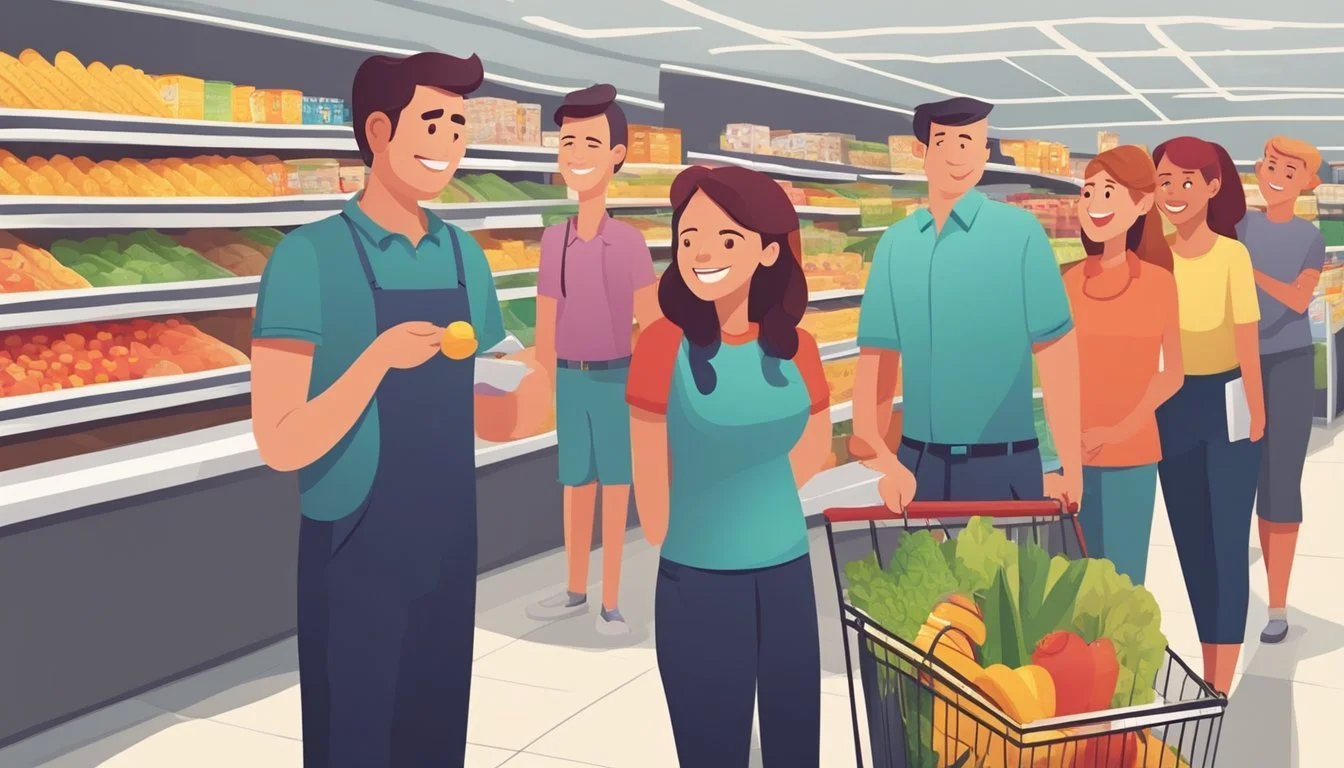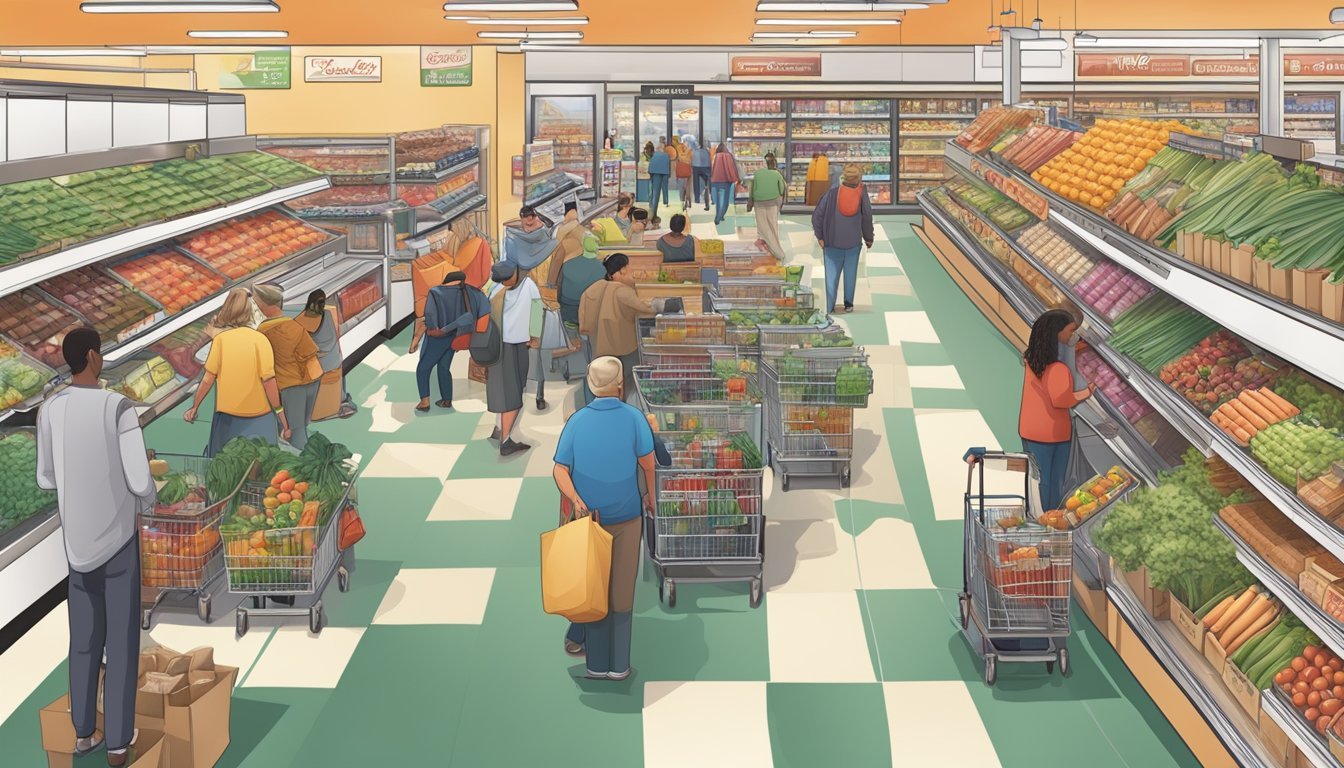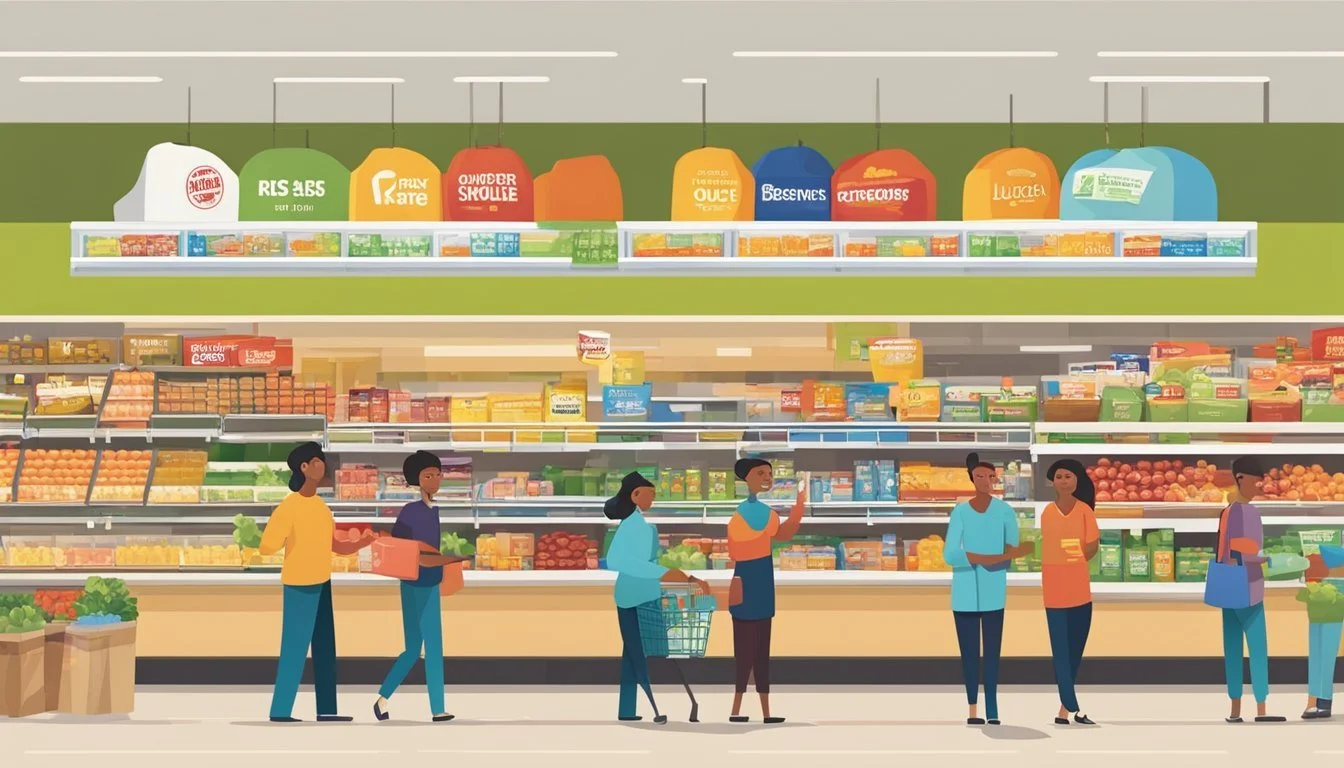Grocery Outlet vs Lucky Supermarkets
A Cost-Effective Comparison for Smart Shoppers
Grocery shopping can be a significant expense for many households, making it essential to find stores that offer the best value for money. Two popular options in some areas are Grocery Outlet and Lucky Supermarkets. Both aim to provide affordable groceries, but they have different approaches and strengths.
Grocery Outlet tends to offer lower prices overall, with costs about 22% below average compared to other stores. This discount grocer focuses on selling overstock and closeout items at steep discounts. Lucky Supermarkets, on the other hand, is a more traditional supermarket chain that offers a wider selection of products, including both name brands and store brands.
The choice between Grocery Outlet and Lucky Supermarkets often comes down to individual preferences and priorities. Shoppers looking for rock-bottom prices on a rotating selection of products may prefer Grocery Outlet. Those who value consistency and a broader range of options might lean towards Lucky Supermarkets. Factors like store location, product quality, and shopping experience also play a role in determining which store is better for each customer.
History and Background
Grocery Outlet and Lucky Supermarkets have roots dating back to the mid-20th century. Both companies have undergone significant changes, adapting to shifts in the grocery industry landscape.
Grocery Outlet History
Grocery Outlet's story began in 1946 when Jim Read opened Cannery Sales in San Francisco. The store initially sold military surplus items at low prices.
Over time, it evolved into a deep-discount grocery store. The business went through several name changes before becoming Grocery Outlet in 1987.
In 2009, the company rebranded as Grocery Outlet Bargain Market. This name reflects their focus on offering discounted, overstocked, and closeout products.
Today, Grocery Outlet operates stores across multiple states, including California, Oregon, Washington, and Pennsylvania.
Lucky Supermarkets History
Lucky Stores was founded in San Leandro, California, in 1935. The chain grew to become a prominent supermarket in the western United States.
In 1998, Albertsons acquired Lucky's parent company, American Stores. By 1999, the Lucky brand had disappeared from most locations.
In 2006, Grocery Outlet briefly used the Lucky name for a store in Rocklin, California. However, they backed off when Supervalu began opening Lucky-branded stores in Southern California and Nevada.
Currently, Lucky is operated by Albertsons in Utah and Save Mart Supermarkets in Northern California.
Transformations in the Grocery Industry
The grocery industry has seen significant changes over the decades. Traditional supermarkets faced increasing competition from discount chains and warehouse clubs.
Online shopping and delivery services have disrupted the market. Companies like Amazon and Walmart have expanded their grocery offerings.
Many chains have adapted by focusing on niche markets or emphasizing low prices. Grocery Outlet, for example, specializes in discounted and closeout items.
The industry continues to evolve, with stores experimenting with new formats and services to meet changing consumer demands.
Product Selection and Quality
Grocery Outlet and Lucky Supermarkets offer distinct product selections and quality levels. Their offerings vary in terms of produce, meats, prepared foods, and brand availability.
Produce and Organic Options
Grocery Outlet provides a rotating selection of produce at discounted prices. The quality can be variable, with some items nearing their peak ripeness. Organic options are available but limited. Lucky Supermarkets maintains a more consistent produce section with a wider range of conventional and organic fruits and vegetables. Their produce tends to have a longer shelf life.
Lucky Supermarkets offers:
Broader selection of organic produce
More consistent quality and freshness
Greater variety of seasonal items
Grocery Outlet provides:
Discounted prices on produce
Occasional deals on organic items
Unpredictable inventory
Meat and Deli Quality
Lucky Supermarkets features a full-service meat and deli counter with trained butchers. They offer a range of cuts and specialty meats. The quality is generally reliable, with options for both budget-conscious shoppers and those seeking premium cuts.
Grocery Outlet's meat selection is more limited. They often carry pre-packaged meats and frozen options at lower prices. The quality can be good, but the selection is less extensive and may not include specialty cuts.
Meat options comparison:
Option Lucky Supermarkets Grocery Outlet Fresh cuts Wide variety Limited Specialty meats Available Rare Pre-packaged Some Predominant Pricing Standard Discounted
Prepared Foods and Delicatessen
Lucky Supermarkets typically offers a more extensive delicatessen with hot and cold prepared foods. Their selection often includes:
Rotisserie chickens
Sandwiches and wraps
Salad bar
Hot food items like fried chicken or pizza
Grocery Outlet's prepared food section is usually smaller. They may have a limited selection of pre-packaged sandwiches, salads, and heat-and-eat meals. The focus is more on convenience items rather than freshly prepared foods.
Brand Variety and Availability
Grocery Outlet is known for its ever-changing inventory of discounted brand-name products. Shoppers can find unexpected deals on popular brands, but availability is inconsistent. They also carry a selection of generic staples and their own private label products.
Lucky Supermarkets offers a more stable selection of national brands, store brands, and local products. Their inventory is more predictable, making it easier for customers to find specific items on repeat visits.
Brand availability:
Grocery Outlet: Rotating selection of discounted brands
Lucky Supermarkets: Consistent stock of popular brands
Both stores carry common household items, but Lucky Supermarkets generally provides a wider range of choices within each product category.
Pricing and Savings
Grocery Outlet and Lucky Supermarkets employ different pricing strategies to attract budget-conscious shoppers. Both stores offer ways to save, but their approaches vary in terms of everyday prices, promotional deals, and loyalty programs.
Comparing Everyday Prices
Grocery Outlet typically offers lower everyday prices compared to Lucky Supermarkets. As a discount grocer, Grocery Outlet's prices are often 20-30% below average supermarket prices. They achieve this by purchasing excess inventory and closeout items from manufacturers.
Lucky Supermarkets' regular prices tend to be higher but still competitive within the traditional supermarket segment. Their pricing strategy focuses more on weekly sales and promotions to attract customers.
For staple items like milk, bread, and eggs, Grocery Outlet usually maintains an edge in pricing. However, prices can fluctuate based on available inventory.
Discounts and Deals
Lucky Supermarkets runs weekly sales advertised through circulars and digital platforms. These promotions often include significant discounts on select items, sometimes reaching 50% off or more. They also use loss leaders - deeply discounted popular items - to draw customers into stores.
Grocery Outlet's approach differs. They don't offer traditional weekly sales. Instead, they provide consistent low prices on a changing inventory. Shoppers can find unexpected deals on brand-name products, sometimes at 40-70% off retail prices.
Both stores offer seasonal sales events, but Lucky tends to have more predictable promotional calendars.
Loyalty Programs and Additional Savings
Lucky Supermarkets offers a loyalty program that provides personalized discounts and digital coupons. Members can accumulate points for additional savings on fuel or groceries.
Grocery Outlet doesn't have a traditional loyalty program. They rely on their everyday low prices as their main savings strategy. However, they occasionally offer store-wide promotions or coupons through their email newsletter.
Lucky's program provides ongoing benefits for frequent shoppers. Grocery Outlet's lack of a loyalty program means no membership is required to access their low prices.
Both stores accept manufacturer coupons, adding another layer of potential savings for savvy shoppers.
Customer Experience and Satisfaction
Grocery Outlet and Lucky Supermarkets offer distinct shopping experiences that cater to different customer preferences. Each store has its own approach to layout, service, and convenience.
Store Layout and Navigability
Grocery Outlet typically features a more compact layout with aisles organized by product categories. The store's design emphasizes bargain hunting, with prominently displayed discount signage throughout.
Lucky Supermarkets often have larger floor plans with wider aisles. Their layout tends to be more traditional, with clearly marked sections for produce, dairy, and other staples.
Both stores aim for easy navigation, but Lucky's consistent layout across locations may be more familiar to regular shoppers. Grocery Outlet's ever-changing inventory can make each visit a unique experience, appealing to customers who enjoy discovering new products.
Customer Service
Grocery Outlet stores are often independently owned and operated, which can lead to a more personalized shopping experience. Staff members are usually knowledgeable about current deals and specials.
Lucky Supermarkets, as part of a larger chain, typically offer standardized customer service training. Employees are generally well-versed in store policies and procedures.
Both stores strive to maintain friendly and helpful staff. However, the level of individual attention may vary depending on the specific location and time of day.
Shopping Convenience
Grocery Outlet focuses on providing deep discounts on a rotating selection of products. This model appeals to budget-conscious shoppers willing to be flexible with their purchases.
Lucky Supermarkets offer a more consistent inventory, making it easier for customers to find specific items on their shopping lists. They often provide additional services like pharmacies and in-store bakeries.
Both stores have adapted to modern shopping trends. Lucky tends to offer more robust online ordering and delivery options, while Grocery Outlet has been expanding its e-commerce presence.
Store hours can vary, but Lucky Supermarkets generally maintain longer operating hours, potentially offering greater convenience for area consumers with busy schedules.
Market Position and Consumer Perception
Grocery Outlet and Lucky Supermarkets occupy distinct positions in the grocery retail landscape. Their brand images, consumer ratings, and market presence significantly influence shopper preferences and loyalty.
Brand Image and Reputation
Grocery Outlet positions itself as a discount retailer offering bargain prices on name-brand and organic products. The company's "treasure hunt" shopping experience appeals to budget-conscious consumers seeking deals. Lucky Supermarkets, on the other hand, maintains a more traditional grocery store image with a focus on fresh produce and everyday essentials.
Both chains strive to create a positive shopping environment, but their approaches differ. Grocery Outlet emphasizes value and unique finds, while Lucky aims for consistent quality and community connection.
Consumer Ratings and Reviews
Consumer ratings for both retailers vary across metro areas. Grocery Outlet generally receives positive feedback for its low prices and product variety. Shoppers appreciate the opportunity to find high-quality items at discounted rates.
Lucky Supermarkets garners praise for its cleanliness and customer service. A Consumer Reports study highlighted store cleanliness as a key factor in customer satisfaction for grocery chains.
Online reviews suggest that Grocery Outlet excels in price competitiveness, while Lucky shines in product freshness and store layout.
Impact of Market Presence
Grocery Outlet's expansion strategy focuses on entering new markets and increasing store density in existing regions. This approach has helped boost brand recognition and accessibility for shoppers.
Lucky Supermarkets maintains a strong presence in certain regions, particularly in California. Its local market knowledge allows for tailored product offerings and community engagement.
Market presence affects consumer perception significantly. Grocery Outlet's growing footprint has increased its visibility, while Lucky's established presence in specific areas fosters customer familiarity and loyalty.
Accessibility and Community Impact
Grocery Outlet and Lucky Supermarkets differ in their approaches to accessibility and community involvement. Their strategies for store locations, community engagement, and support for local producers shape their impact on neighborhoods and customers.
Location and Area Coverage
Grocery Outlet typically focuses on smaller, more affordable retail spaces in diverse neighborhoods. This approach allows them to serve areas that larger supermarkets might overlook. Their stores are often found in strip malls or standalone buildings, making them accessible to nearby residents.
Lucky Supermarkets, on the other hand, tends to have larger stores in more established commercial areas. They often anchor shopping centers, providing a one-stop shopping experience. Lucky's locations are generally more spread out, covering wider geographic areas.
Both chains strive to be accessible by public transportation and offer parking lots for customers arriving by car. Grocery Outlet's smaller footprint can make it easier to integrate into dense urban areas, while Lucky's larger stores may be more convenient for suburban shoppers.
Community Engagement
Grocery Outlet operates on an owner-operator model, with local families running individual stores. This structure fosters strong community ties and personalized customer service. Store operators often participate in local events and support neighborhood initiatives.
Lucky Supermarkets, as part of a larger corporation, engages in broader community programs. They frequently sponsor local sports teams, school events, and charitable organizations. Lucky also organizes food drives and partners with food banks to address hunger in their communities.
Both grocery chains offer loyalty programs and digital coupons to help customers save money. Grocery Outlet's deals tend to be more spontaneous due to their opportunistic buying model, while Lucky offers more consistent weekly specials and promotions.
Support for Local Producers
Grocery Outlet's unique business model allows them to feature local and regional products alongside national brands. They often provide opportunities for small producers to sell excess inventory or test new products in their stores.
Lucky Supermarkets maintains partnerships with local farmers and food artisans, especially in their produce and deli departments. They highlight locally sourced items and sometimes host in-store events featuring local vendors.
Both chains recognize the importance of supporting local economies. Grocery Outlet's flexible purchasing allows for quick integration of local products, while Lucky's established relationships with suppliers provide more consistent local offerings. Customers benefit from access to fresh, regional products at both stores.
Additional Services and Features
Grocery Outlet and Lucky Supermarkets offer various conveniences beyond basic grocery shopping. These include delivery options and special perks for loyal customers. The specific services can make a significant difference in the overall shopping experience.
Grocery Delivery and Pickup Options
Grocery Outlet does not provide company-wide delivery or pickup services. Some individual stores may partner with third-party delivery apps, but this varies by location. Customers typically need to shop in-store.
Lucky Supermarkets, on the other hand, offers delivery through Instacart in many areas. This service allows customers to order groceries online and have them delivered to their homes. Lucky also provides curbside pickup at select locations.
Neither chain has an official partnership with Amazon Prime for grocery delivery or discounts.
Member-Exclusive Benefits
Grocery Outlet operates a "WOW Rewards" program. Members earn points on purchases, which can be redeemed for store credit. The program also provides exclusive offers and early access to certain deals.
Lucky Supermarkets has a digital rewards program called "Lucky You Rewards." Members receive personalized deals, digital coupons, and can earn points toward gas discounts at participating stations.
Both programs are free to join and offer savings opportunities. Lucky's program integrates with its delivery service, allowing members to use their benefits for online orders.





